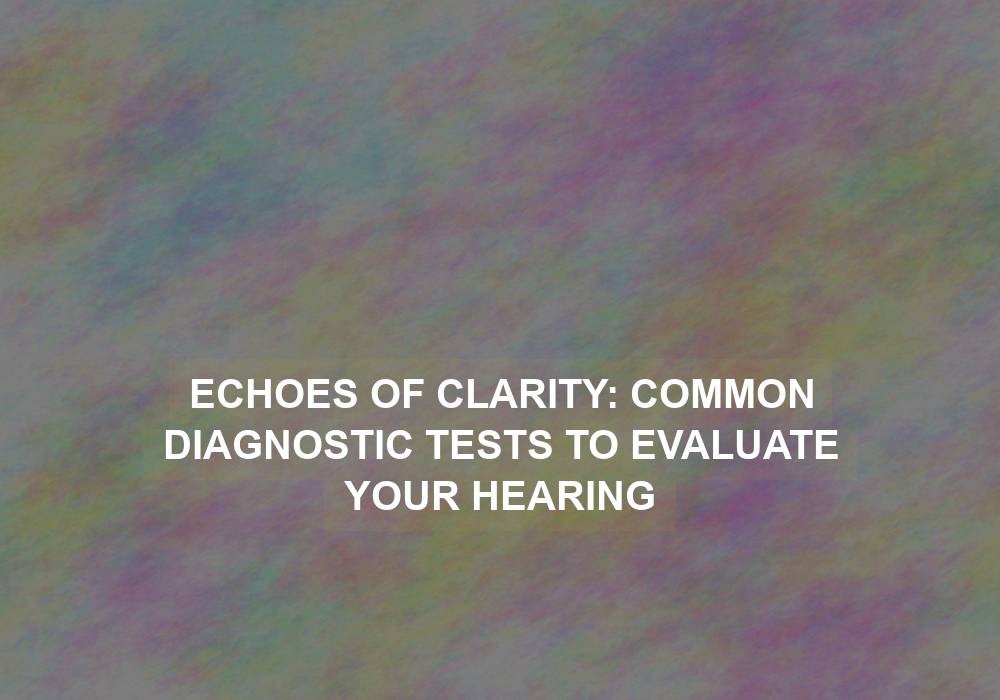Hearing loss is a common condition that can significantly impact a person’s quality of life. Whether you are experiencing potential hearing problems or simply want to assess the health of your auditory system, undergoing diagnostic tests can provide valuable insights. In this article, we will explore some of the most common diagnostic tests used by audiologists to evaluate hearing and identify potential hearing impairments.
Audiometry
Audiometry is the most basic and commonly performed hearing test. It assesses a person’s ability to hear sounds at different frequencies and volumes. During an audiometry test, the patient wears headphones and listens to a series of tones at varying frequencies and volumes. The patient indicates when they can hear the sound, and the audiologist records the results on an audiogram.
An audiogram is a graph that shows the patient’s hearing thresholds at different frequencies. This test helps identify the type and degree of hearing loss a person may have. It also aids in determining the appropriate treatment options, such as hearing aids or cochlear implants.
Some key points about Audiometry include:
- It is a non-invasive test that provides valuable information about a person’s hearing abilities.
- By measuring hearing thresholds at different frequencies, audiologists can determine the specific type and degree of hearing loss.
- Audiometry is essential in identifying suitable treatment options, such as hearing aids or cochlear implants, based on the individual’s hearing needs.
Tympanometry
Tympanometry is a test that evaluates the health and functionality of the middle ear. It measures the movement of the eardrum in response to changes in air pressure. This test can identify conditions such as eustachian tube dysfunction, fluid in the middle ear, or a perforated eardrum.
During the test, the audiologist inserts a small probe into the patient’s ear canal. The probe emits a tone and changes the air pressure in the ear. By measuring the eardrum’s response to these pressure changes, the audiologist can determine if the middle ear is functioning properly.
Some important details about Tympanometry include:
- It is a painless and quick test that provides valuable information about the health of the middle ear.
- Tympanometry helps identify conditions such as eustachian tube dysfunction, which can affect the middle ear’s ability to equalize pressure.
- It is particularly useful in diagnosing conditions like fluid in the middle ear or a perforated eardrum, which can cause hearing loss.
Otoacoustic Emissions (OAE) Test
Otoacoustic Emissions (OAE) test is a non-invasive procedure that assesses the health of the inner ear, specifically the cochlea. This test measures the sounds produced by the inner ear in response to a stimulus. By analyzing these emissions, the audiologist can determine if the cochlea is functioning correctly.
During the test, a small probe is placed in the patient’s ear canal. The probe emits a series of low-level sounds, and the inner ear responds by producing an echo. The probe detects and records these echoes, allowing the audiologist to evaluate the integrity of the cochlea.
Some key points about Otoacoustic Emissions (OAE) Test include:
- It is a valuable test to assess the health of the inner ear, particularly the cochlea.
- OAE testing is non-invasive and provides important information about the integrity of the cochlea’s functioning.
- By analyzing the echoes produced by the inner ear, audiologists can determine if there are any abnormalities or impairments that may be causing hearing loss.
Speech Audiometry
Speech audiometry is a test that evaluates a person’s ability to hear and understand speech. It assesses the patient’s speech reception threshold (SRT) and word recognition score (WRS). This test helps determine the impact of hearing loss on a person’s ability to communicate effectively.
During the test, the audiologist presents recorded or live speech stimuli to the patient through headphones. The patient repeats or identifies the words they hear, and the audiologist records the results. Speech audiometry provides crucial information about a person’s ability to understand speech in various listening environments.
Some important details about Speech Audiometry include:
- It focuses on assessing a person’s ability to comprehend and interpret speech.
- Speech audiometry measures the speech reception threshold (SRT) and word recognition score (WRS).
- This test helps determine how well a person can understand speech in different listening scenarios, providing valuable insights into the impact of hearing loss on communication.
Bone Conduction Test
Bone conduction testing assesses the hearing ability of an individual by bypassing the outer and middle ear. It directly stimulates the inner ear using a bone oscillator placed behind the ear or on the forehead. This test helps determine if the hearing loss is conductive or sensorineural in nature.
During the test, the bone oscillator sends vibrations through the bones of the skull to the inner ear. The patient indicates when they can hear the sound, and the audiologist records the results. Bone conduction testing is particularly useful in differentiating between conductive and sensorineural hearing loss.
Some key points about Bone Conduction Test include:
- It assesses the hearing ability by directly stimulating the inner ear using bone conduction.
- This test helps determine if the hearing loss is due to a problem in the outer or middle ear (conductive) or in the inner ear or auditory nerve (sensorineural).
- By bypassing the outer and middle ear, bone conduction testing provides important information about the integrity and functionality of the inner ear.
Conclusion
If you suspect any hearing problems or simply want to assess the health of your auditory system, undergoing diagnostic tests can provide valuable information. Audiometry, tympanometry, OAE testing, speech audiometry, and bone conduction testing are some of the most common diagnostic tests used by audiologists. By evaluating the results of these tests, audiologists can determine the type and degree of hearing loss and recommend appropriate treatment options. Remember, early diagnosis and intervention are key to managing hearing impairments effectively and improving your overall quality of life.
